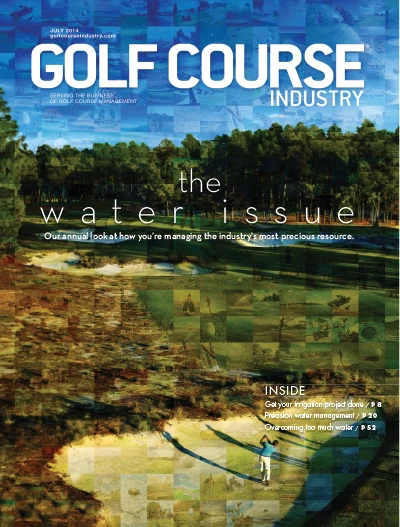
 Jeffrey D. Brauer |
Golf has a water problem, from both regulatory and public perception points of view. These photos show how some regulators and many in the public view golf as it is, and as they think it should be. Initially, the response was denial, then humor – “They want water conservation – I’ll order whiskey straight, rather than waste water.” Now, most “get it” (meaning the challenges of the future regulatory landscape) and the golf industry made great strides toward that water conservation goal in the last decade, while still fighting to keep golf courses from being a great place to hide UPS trucks. We have a pretty good story to tell:
However, what we call a “good story” is probably only a “good start” to regulators, and we can expect increasingly restrictive irrigation mandates moving forward, resulting in harder, more painful steps to be taken soon. Jim Moore, the director of the USGA Green Section’s Education Program, knows this. His presentations on this subject are among the most interesting – and eye-opening – I have seen in a while. To answer the question “What more can we do to reduce highly irrigated turf?” Moore quotes H. James Harrington, author of “Business Process Improvement.”
Moore has measured a few courses, employing drones, golfer tracking devices and other technology, in the name of searching out unnecessary irrigation and maintenance. This kind of measurement is invaluable to clubs, golf course architects and irrigation designers in producing either new designs or redesigns, or in preparing turf/irrigation reduction plans for courses. The intuitive and creative art form that is golf course architecture has always relied on some math and measurements – just how big does that green need to be? – to turn creative ideas into practical golf courses, and this is both a continuation of that and a bold new phase in water reduction. A typical example is shown here: to irrigate about 5,000 square feet of actual tee surface, about 50,000 square feet – approximately 10 times and one acre more – receives irrigation. This suggests that desert-style tee irrigation, consisting of small pop up heads watering only the tee surfaces, could save almost 18 acres of turf on a typical “all-turf” course. That is likely a 10 to 15 percent turf reduction. Under typical Texas irrigation, this course might save 10 to 12 million gallons a year. Your actual reduction might be less, but even half that irrigation reduction may be significant in a water-starved future. The reason this really resonated with me is that on recent projects I actively designed in reduced-tee watering areas, using small double rows of heads to water a 35- to 40-foot strip the length of the tee. I was satisfied about my water conservation methods at the time, but now see I could have gone even further – my target goal is Moore’s starting point for further reductions! He feels like an old coach telling me that I’m trying hard to reduce irrigation, but perhaps not giving that legendary 110 percent. Moore also calculated other substantial maintenance reductions for tee only irrigation that might allow resource allocation to other critical maintenance areas:
In my master plans and turf/water reduction plans, I also consider reducing rough. Here, I use my experience and some limited studies on where shots land to guide design. Moore suggests new technology can exactly determine where to cut back rough irrigation on your course, based on your actual player movement. In a test, they equipped golfers with monitors, which showed many turf areas receiving no or minimal traffic, thereby suggesting the best areas to turn off the water and/or convert to natives of some type, as shown in Moore’s image below. Even with true measurement of play density, the trade-offs of less turf and lost balls/slow play haven’t changed, even if the need for water conservation has. Any turf reductions must include a value judgment. Turning off water where no one plays is easy. But what about one player a month? A week? A day? A half-day? An hour?
While your actual day of reckoning for water reduction may be a decade away, the time to start planning is now. Reducing highly maintained turf is a given moving forward. Every course requires a well thought out plan, and the tools are there to accomplish that efficiently.
Jeffrey D. Brauer is a veteran golf course architect responsible for more than 50 new courses and more than 100 renovations. A member and past president of the American Society of Golf Course Architects, he is president of Jeffrey D. Brauer/GolfScapes in Arlington, Texas. Reach him at jeff@jeffreydbrauer.com. |

Explore the July 2014 Issue
Check out more from this issue and find your next story to read.
Latest from Golf Course Industry
- Standard Golf announces new product lineup for 2025
- The Salt Pond taps Troon for management
- KemperSports selected to manage Swansea Country Club
- From the publisher’s pen: Grab that guide
- Introducing our April 2025 issue
- South Carolina leaders honor golf course superintendent
- One and only
- Wild can be good









